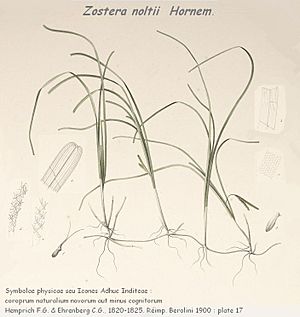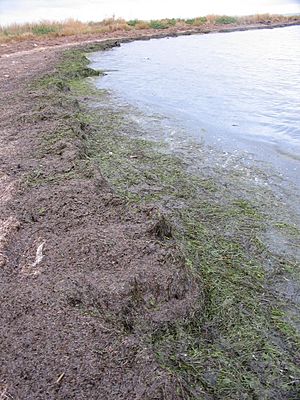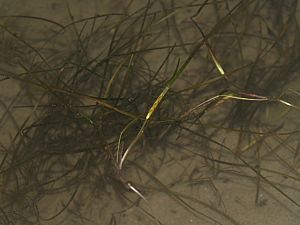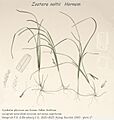Dwarf eelgrass facts for kids
Quick facts for kids Dwarf eelgrass |
|
|---|---|
 |
|
| Conservation status | |
| Scientific classification | |
| Genus: |
Zostera
|
| Species: |
noltii
|
| Synonyms | |
|
List
|
|
Dwarf eelgrass, also known as Zostera noltii, is a special type of seagrass. It lives in shallow ocean waters near coasts. You can find it in places like northwestern Europe, the Mediterranean Sea, the Black Sea, the Caspian Sea, and the Aral Sea. It also grows on islands off the coast of northwest Africa. This plant is super important for the health of coastal areas. It helps keep estuaries, bays, and lagoons healthy.
Contents
What is Dwarf Eelgrass?
Dwarf eelgrass has a special stem called a rhizome. This rhizome creeps along just under the sand or mud on the seabed. From this rhizome, groups of two to five long, thin leaves grow upwards. Each part of the rhizome also has up to four short roots. These roots help the plant stay firmly in the sand.
Leaves and Flowers
The leaves of dwarf eelgrass are about 22 centimeters (almost 9 inches) long. They have three veins running along them and blunt, notched ends. Inside the leaves are air spaces, which help them float in the water.
This plant has separate male and female flowers. These tiny flowers grow on a short, spear-shaped stem that comes off the main plant. The seeds are smooth and white, about 2 millimeters long. They grow inside a green, thin-walled capsule.
Where Dwarf Eelgrass Lives

Dwarf eelgrass grows in the eastern Atlantic Ocean. It can be found along the coasts of Europe, reaching as far north as Norway, Sweden, and the Baltic Sea. In the British Isles, it grows a lot in places like the Firths of Moray and Cromarty. You can also find it in The Wash and the Thames Estuary.
Specific Locations
In Ireland, large amounts of dwarf eelgrass are found in Strangford Lough, Dungarvan Harbour, and Dublin Bay. In the Mediterranean Sea and the Black Sea, it prefers salty water found in lagoons and estuaries. It is the only type of seagrass that lives in the Caspian Sea and the Aral Sea. It also grows in Morocco, Mauritania, the Canary Islands, and Cape Verde.
Habitat Conditions
Dwarf eelgrass usually grows in fine sand or mud. It can handle different levels of saltiness in the water. It often grows higher up on the beach than other seagrasses. Sometimes, it mixes with other types of seagrasses. It can also grow in deeper water in estuaries and lagoons, especially where the water is less salty. However, it doesn't do well with too many nutrients in the water or if the water is cloudy.
Life Cycle of Dwarf Eelgrass
The growth of dwarf eelgrass begins in the spring. New leaves appear, and the underground rhizome grows longer and branches out. By summer, thick beds of these plants cover the sandy flats. This is also when the plants flower.
Seasonal Changes
In autumn, the growth slows down. During winter, most of the leaves break off or are eaten by birds. Only the underground rhizomes remain. These rhizomes can live for many years, helping the plant regrow each spring.
Reproduction
Male flowers release tiny strands of pollen. This pollen floats in the water and can fertilize female flowers for several days. The seed capsules can perform photosynthesis, just like leaves. They also have a small air bubble inside. After a few weeks, the capsules open, and the seeds sink to the bottom.
Sometimes, the capsules break off and float away before opening. This helps spread the seeds to new places. Waves and currents carry the seeds, and sometimes birds can even help by carrying them on their feet or in their stomachs. However, new plants growing from seeds are not very common. Most new dwarf eelgrass plants grow from pieces of the rhizome breaking off and starting new plants.
Importance of Dwarf Eelgrass in Ecosystems
Seagrass beds are very important parts of coastal ecosystems. They are like underwater forests. Many different types of algae grow on dwarf eelgrass. These include brown algae species like Cladosiphon zosterae and Halothrix lumbricalis.
Role in the Food Web
Eelgrass beds provide a safe home for many small sea creatures without backbones (invertebrates). They also offer a safe place for young fish to grow. When the leaves of dwarf eelgrass decay in winter, they enrich the sand and mud. This decaying material forms the base of a food chain. Tiny organisms called protists and bacteria feed on these decaying parts, which then become food for other creatures.
Food for Birds
Dwarf eelgrass is a very important winter food for several types of birds. These include the whooper swan (Cygnus cygnus), the mute swan (Cygnus olor), the brent goose (Branta bernicla), and the wigeon (Anas penelope). In fact, the number of brent geese in Europe has gone down because a disease has reduced the amount of eelgrass available. Wigeon numbers have also decreased. These birds are shy and only eat dwarf eelgrass when other food sources are gone.
Coastal Protection
Dwarf eelgrass and other seagrasses help keep the sand and mud stable on the seabed. They also reduce the energy of waves, which can protect coastlines from erosion. However, dwarf eelgrass can be harmed if it gets covered by too much moving sand. It also has a hard time recovering if it gets buried. This might be because its leaves are relatively short.
Even though it supports many different animal species, there are more animals in eelgrass beds that are always underwater. While dwarf eelgrass populations might be slowly decreasing, the IUCN Red List of Threatened Species says it is of "least concern". This means it is not currently in danger of disappearing.
Images for kids
See also
 In Spanish: Zostera noltii para niños
In Spanish: Zostera noltii para niños




